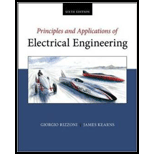
List five applications of electric motors in thecommon household.
To discuss:
Five applications of electric motors in the common household.
Explanation of Solution
An electric motor is a machine that converts electrical energy into mechanical energy. The electric motor has a rotating part, which rotates due to the interaction between the magnetic field and the electric current in the motor. Depending on the type of power source are mainly two types of electric motors, AC motors and DC motors.
The type of electric motors used depends upon the application for which they have been employed. The type of motor can be single-phase ac motor, three-phase ac motor, or a dc motor. The electric motors have a wide range of applications like industrial, commercial, and household applications.
The first household application of an electric motor is an electric fan. The electric motor employed in fan is single phase ac motor and consumes very less power, therefore, also called fractional kilowatt motor.
The second household application of electric motor is in the washing machine, which generally employs a universal motor that can operate both AC and DC power.
The third household application of the electric motor is in the air conditioner, which employs ac motor that operates at
The fourth household application of the electric motor is in hairdryers, which employ a permanent magnet DC motor, which runs at a very high speed of
The fifth household application of the electric motor is in the refrigerator in which they are used to compress the coolant, as the most common type of motor used in HVAC applications is AC motor only.
Therefore, the five main applications of the electric motors in the household are electric fans, washing machines, air conditioners, hairdryers, and refrigerators.
Want to see more full solutions like this?
Chapter 1 Solutions
Principles and Applications of Electrical Engineering
- Don't use ai to answer I will report you answerarrow_forward3) Find the valve of V using the Thevenin Equivalent Circuit and then determine if the 8 ohm resistor allows maximum power transfer. If not, then what value should the 8 ohm resist or be changed to for maximum power transfer? ZA 360 Am 6t + 22V V 3402 22 62 Mw marrow_forwardFind the valve of the voltage Vx using the THEVENIN 2) equivalent circuit and redo the problem with the NORTON equivalent circuit. Show both the flavinen and Norton Circuits DAY ww 1 23 www + 4444 5 63arrow_forward
- Figure shows the block diagram of a feedback control system with a disturbance signal N(s). Obtain the output Y(s) due to both R(s) and N(s).arrow_forwardA 3-phase, 6-pole induction motor is con- nected to a 60 Hz supply. The voltage in- duced in the rotor bars is 4 V when the ro- tor is locked. If the motor turns in the same direction as the flux, calculate the approxi- mate voltage induced and its frequency: a. At 300 r/min b. At 1000 r/min c. At 1500 r/minarrow_forwardMake a drawing of the magnetic field cre- ated by a 3-phase, 12-pole induction motor. How can we change the direction of rota- tion of a 3-phase induction motor?arrow_forward
- Describe the principle of operation of a lin- ear induction motor.arrow_forwardName the principal components of an in- duction motor. Explain how a revolving field is set up in a 3-phase induction motor.arrow_forwardAnswer all the questions (a) How much power is the wind farm generating? (b) How much power is the solar farm generating? (c) Find the power delivered to the AC motor. (d) If the AC motor requires at least 45 kW of power, is the system able to provide that power? If not, how many additional series PV modules should be added to each string (we want to keep the same number of modules in each string)? If so, how many modules can be removed from each string while still meeting the requirements?arrow_forward
- An open-circuit voltage of 240 V appears across the slip-rings of a wound-rotor in- duction motor when the rotor is locked. The stator has 6 poles and is excited by a 60 Hz source. If the rotor is driven by a variable-speed dc motor, calculate the open-circuit voltage and frequency across the slip-rings if the dc motor turns a. At 600 r/min, in the same direction as the rotating field b. At 900 r/min, in the same direction as the rotating field c. At 3600 r/min, opposite to the rotating fieldarrow_forwardIf we double the number of poles on the stator of an induction motor, will its syn- chronous speed also double? The rotor of an induction should never be locked while full voltage is being applied to the stator. Explain. Why does the rotor of an induction motor turn slower than the revolving field?arrow_forwarda. Calculate the synchronous speed of a 3-phase, 12-pole induction motor that is excited by a 60 Hz source. b. What is the nominal speed if the slip at full-load is 6 percent?arrow_forward
 Delmar's Standard Textbook Of ElectricityElectrical EngineeringISBN:9781337900348Author:Stephen L. HermanPublisher:Cengage Learning
Delmar's Standard Textbook Of ElectricityElectrical EngineeringISBN:9781337900348Author:Stephen L. HermanPublisher:Cengage Learning
